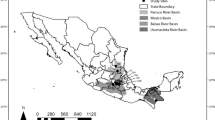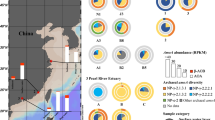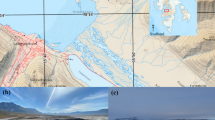Abstract
In this study, we investigated the bacterial communities in the shrimp and sea cucumber culture environment, including shrimp ponds (SP), sea cucumber ponds (SCP), mixed-culture ponds (MCP) and the effluent channel (EC) in Qingdao, China. Bacteria cultivation showed that the counts of heterotrophic, nitrate-reducing and sulfate-reducing bacteria in the sediment of SP were higher than that in the sediment of SCP and MCP, varying between 8.7 × 104 and 1.86 × 106, 2.1 × 104 and 1.1 × 105, and 9.3 × 101 and 1.1 × 104 CFU g−1, respectively. In contrast, the counts of ammonium-oxidizing and nitrifying bacteria in the sediment of SP was lower than that in the sediment of SCP and MCP. Denaturing gradient gel electrophoresis (DGGE) of 16S rDNA gene and dendrogram analyses showed that bacterial diversity in the mixed-culture environment was higher than that in the monocultures. The similarity of bacterial community between EC and SCP or MCP was higher than that between EC and SP. These results indicated that sea cucumber culture played a significant role in influencing the environmental bacterial communities that were composed mainly of Flavobacteriaceae (64.3%), Bacteriodetes (21%) and delta proteobacteria (14.7%), including the genera of Croceimarina, Lutibacter, Psychroserpens and so on. The results explained the benefit of sea cucumber culture in shrimp ponds at the level of microbial ecology.





Similar content being viewed by others
References
Amann RI, Ludwig W, Schleifer KH (1995) Phylogenetic identification and in situ detection of individual microbial cells without cultivation. Microbiol Rev 59:143–169
Beate K, Reinhard W, Bert E, Heribert C, Henrik S (2005) Microbial diversity in coastal subsurface sediments: a cultivation approach using various electron acceptors and substrate gradients. Appl Environ Microbiol 71(12):7819–7830
Berthelet M, Whyer L, Greer C (1996) Rapid, direct extraction of DNA from soils for PCR analysis using polyvinylpolypyrrolidon spin columns. FEMS Microbiol Lett 138:17–22
Chang Z, Yi J, Mu K (2003) Factors influencing growth and survival of Apostichopus japonicus. Hebei Fish 2:32–36
Chen S, Bao W, Li B (1987) Pollution situation of Rushan Bay and analysis of heterotrophic microorganisms. J Ocean Coll Shandong 17(4):86–94
Don R, Cox P, Wainwright B, Baker K, Mattick J (1991) Touchdown PCR to circumvent spurious priming during gene amplification. Nucleic Acid Res 19:4008
Fortin N, Beaumier D, Lee K, Greer C (2004) Soil washing improves the recovery of total community DNA from polluted and high organic content sediments. J Microbiol Methods 56:181–191
Guo P, Xu M (1994) The bacterial variation in the water environment of cultured prawn pond. Oceano et limno Sinica 25:625–629
Jiang W, Zhang S, Liu Y (2006) Try of culturing sea cucumber, Apostichopus japonicus in shrimp ponds. Shandong Fish 23(9):23–24
Juck D, Charles T, Whyte L, Greer C (2000) Polyphasic microbial community analysis of petroleum hydrocarbon-contaminated soils from two northern Canadian communities. FEMS Microbiol Ecol 33:241–249
Juck D, Driscoll BT, Charles T, Greer CW (2003) Effect of experimental contamination with the explosive hexahydro-1,3,5-trinitro-1,3,5-trazine on soil bacterial communities. FEMS Microbiol Ecol 43:255–262
Li X (2002) The impact of effluent from shrimp ponds to near-shore marine culture and strategies to prevent it. J Chin Fish Econ (6):40–42
Li Y, Wang Y, Wang L (1994) The choose of environment and multiplication sea region Apostichopus japonicus of sea cucumber. Bull Oceanol Limnol 4:42–47
Li Q, Chen B, Qu K, Yuan Y, Li J, Sun X, Zhao F (2002a) Variation of bacteria numbers in fish-shrimp mix-culturing ecosystem. Chin J Appl Ecol 13:731–734
Li Q, Qu K, Chen B, Sun X, Li J, Zhao F (2002b) Seasonal variation of some main bacteria groups in old shrimp pond ecosystem. Mar Fish Res 23(2):45–49
Li Q, Chen B, Qu K, Xin F, Li J, Zhao F (2002c) Vertical distribution of three main bacteria groups in sediment of shrimp ponds. J Fish Sci China 9:367–370
Li Z, He L, Wu J, Chen J (2005) Study on predominant bacteria community in prawn based on 16S rDNA PCR–DGGE fingerprint. J Fish China 32(3):82–86
Liao Y (1979) Sea cucumber in China. Mar Sci 3:54–58
Liu G, Li D, Dong S, Wang K (2000) Numerical dynamics of sediment bacteria in shrimp polycultural ecosystems. Chin J Appl Ecol 11(1):138–140
Liu S, Yang H, Zhou Y, Zhang T, Yuan X (2006) Simulative studies on utilization efficiency of Apostichopus japonicus on the biodeposit in the raft culture system in shallow sea. Mar Sci 30(12):21–24
Luo P, Hu C, Xie Z, Zhang L, Ren C, Xu Y (2006) PCR–DGGE analysis of bacterial community composition in brackish water Litopenaeus vannamei culture system. J Trop Oceanogr 25(2):49–53
Moesendeder MM, Arrieta JM, Muzer G, Winter C, Hernd GJ (1999) Optimization of terminal-restriction fragment length polymorphism analysis for complex marine bacterioplankton communities and comparison with denaturing gradient gel electrophoresis. Appl Environ Microbiol 65:3518–3525
Murray AE, Hollibaugh J, Orrego TC (1996) Phylogenetic compositions of bacterioplancton from two California estuaries compared by denaturing gradient gel electrophoresis of 16S rDNA fragments. Appl Environ Microbiol 62:2676–2680
Muyzer G, de Waal EC, Uitterlinden AG (1993) Profiling of complex micirobial populations by denaturing gradient gel electrophoresis analysis of ploymerase chain reaction-amplified geens coding for 16S rRNA. Appl Environ Microbiol 59:695–700
Rolleke S, Muyzer G, Wanner G, Lubitz W (1996) Identification of bacteria in a biodegraded wall painting by denaturing gradient gel electrophoreses of PCR-amplified gene fragments coding for 16S rRNA. App Environ Microbiol 62:2059–2065
Sanda R, Magnesen T, Torildsen L, Bergh O (2003) Characterisation of the bacterial community associated with early stages of great scallpo (Pecten maximus), using denaturing gradient gel electrophoresis (DGGE). Syst Appl Microbiol 26(2):302–309
Scharer M, Massana R, Pedros-Alio C (2000) Spatial differences in bacterioplankton composition along the Catalan coast NW Mediterranean assessed by molecular finger-printing. FEMS Microbiol Ecol 33:51–59
Sheffield V, Cox D, Lerman L, Myers R (1989) Attachment of a 40-base-pair G+C-rich sequence (GC-clamp) to genomic DNA fragments by the polymerase chain reaction result in improved detection of single-base changes. Proc Natl Acad Sci 86:139–151
Song Z, Wang S, Xu J, Liu Z, Wang H (2007) Study on reform of the sea cucumber farming pattern in shrimp pond. Hebei Fishies 4:16–18
Staufenberger T, Thiel V, Wiese J, Imhoff J (2008) Phylogenetic analysis of bacteria associated with Laminariasaccharina. FEMS Microbiol Ecol 64:65–77
Thomas EF, Chang L, Presser JI (2006) Changes in the community structure and activity of beta proteobacterial ammonia-oxidizing sediment bacteria along a freshwater-marine gradient. Environ Microbiol 8(4):684–696
Uthicke S, Karez R (1999) Sediment patch selectivity in tropical sea cucumber (Holothurioidea Aspidochirotida) analysed with multiple choice experiments. J Exp Mar Biol Ecol 236:69–87
Wang R (2003) The environmental pollution by marine culture and its appropriate prevention and cure. J Zhejiang Ocean Univ (Nat Sci) 22(3):60–62
Yu Z, Lin F, He J (1995) Relationship between heterotrophic bacteria and shrimp disease. Acta Oceanologica Sinica 17(3):85–90
Acknowledgments
Financial support of this work was provided by the Fund for postdoctoral research of Shandong Province (200601011), the National high-technology development programs(2006AA10Z414, 2006AA10Z415). We thank Professors Cui Yi and Jun Zhao for their help in sample collection. We are also grateful for Xiaoxi Wang for help in sample treating.
Author information
Authors and Affiliations
Corresponding author
Rights and permissions
About this article
Cite this article
Li, Q., Zhang, Y., Juck, D. et al. Phylogenetic analysis of bacterial communities in the shrimp and sea cucumber aquaculture environment in northern China by culturing and PCR–DGGE. Aquacult Int 18, 977–990 (2010). https://doi.org/10.1007/s10499-009-9316-9
Received:
Accepted:
Published:
Issue Date:
DOI: https://doi.org/10.1007/s10499-009-9316-9




